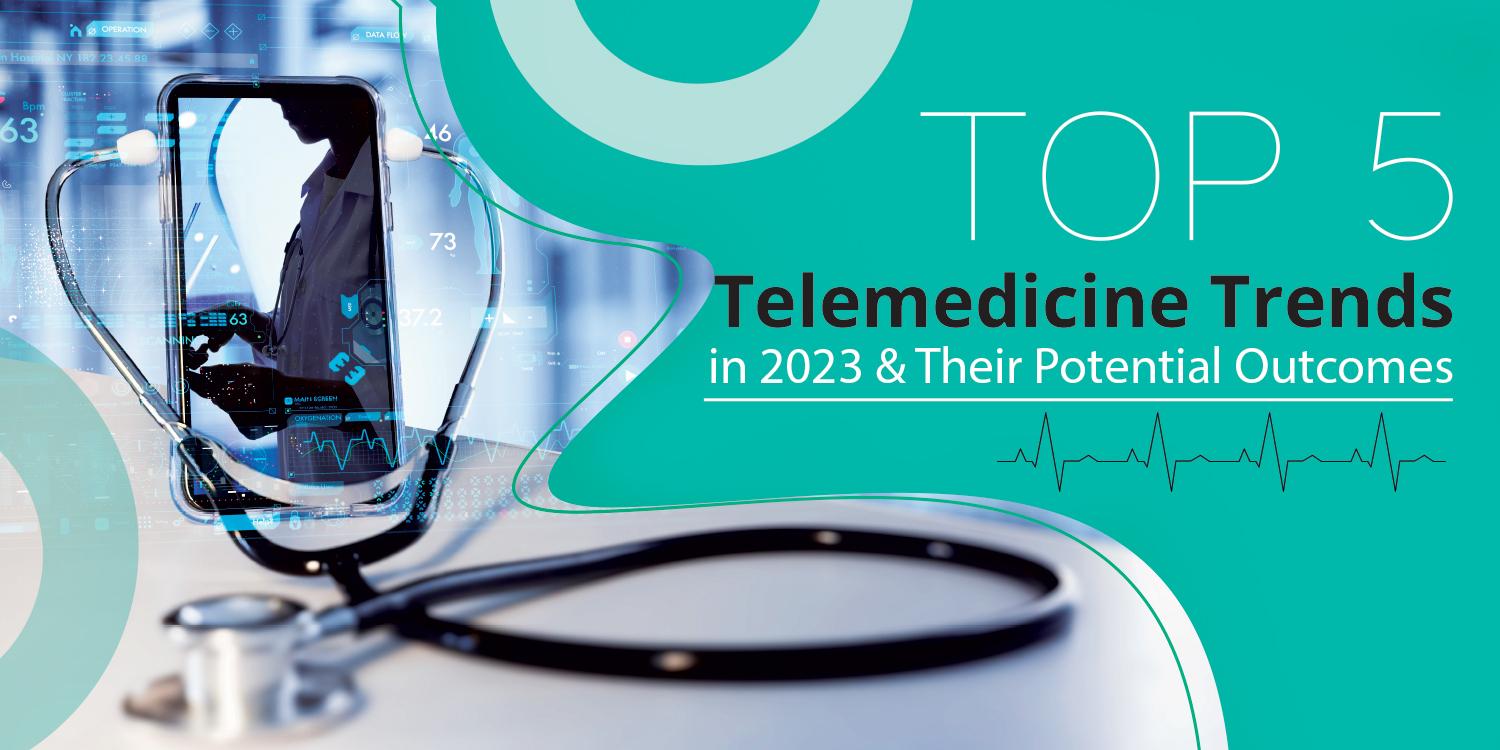Top 5 Telemedicine Trends in 2024 & Their Potential Outcomes
As the world rapidly evolves, so does how we approach healthcare. White-label telemedicine services have been on the rise for years, but in 2024, it’s set to take the healthcare industry by storm. From virtual consultations to remote monitoring, the latest telemedicine trends offer countless benefits.
In this blog, we’ll explore the top telemedicine trends shaping healthcare’s future in 2024. We will also discuss tips to leverage these trends. So, sit back, relax, and get ready to discover the exciting world of Telemedicine!
Table of Contents
- Telemedicine Trends
- The Potential Outcomes: Better Care and Market Positioning
- The Good News: VCDoctor has All This and More
- VCDoctor is Fully White-Label
- Conclusion
- FAQ’S
Telemedicine Trends
1: Artificial Intelligence (AI) and Machine Learning
Artificial intelligence (AI) and machine learning are the future of Telemedicine. With these technologies, healthcare providers can analyze vast amounts of patient data. These insights help make accurate diagnoses and treatment plans.
Benefits for Patients and Providers:
- Faster, more accurate diagnoses
- Personalized treatment plans
- Improved patient outcomes
- Reduced healthcare costs
How can Telemedicine help?
With Telemedicine, providers can leverage AI and machine learning to offer patients personalized yet affordable care. Patients can receive expert care from the comfort of their own homes. It is free from the hassle of visiting a physical doctor’s office.
2: Remote Monitoring
Remote monitoring is another telehealth trend that is set to explode in 2023. With remote monitoring, patients can track their health status and receive timely interventions when needed. Whether you have a chronic condition, are recovering from surgery, or simply want to stay on top of your health, remote monitoring can help.
Benefits for Patients and Providers:
- Improved patient outcomes
- Reduced hospital readmissions
- Increased patient engagement
- Reduced healthcare costs
How can Telemedicine help?
By offering remote monitoring services, telemedicine providers can help patients stay on top of their health and receive timely interventions. This can lead to improved patient outcomes and reduced healthcare costs over time.
3: Virtual Reality (VR)
Virtual reality (VR) will be a game-changer for digital health trends in 2023. With VR, patients can experience medical simulations to understand their conditions and treatments better. Whether a patient is undergoing a complex medical procedure or simply wants to learn more about his/her health.
Benefits for Patients and Providers:
- Improved patient education and engagement
- Reduced anxiety and stress for patients
- More efficient training for healthcare professionals
- Improved patient outcomes
How can Telemedicine help?
Telemedicine services can help patients better understand their health conditions and treatments. This can lead to improved patient outcomes and reduced healthcare costs over time.
4: Integration with Smart Wearables
Telemedicine is a way for doctors to care for patients who can’t visit the doctor’s office. One helpful tool for Telemedicine is wearable devices, like watches and bracelets. These devices can measure heart rate, blood pressure, and blood sugar levels. They send this information to the doctor, who can see if there are any problems and help the patient stay healthy.
Wearable devices also help patients be more involved in caring for their health. Patients can use the devices to track and measure their progress. Doctors can use the information from the devices to ensure each patient gets the right care for their needs, even from a distance.
How can Telemedicine help?
Integrating wearable devices with the Telemedicine app is a very helpful way for doctors to care for people who can’t always go to the doctor’s office. By using wearable devices, doctors can help keep patients healthy and catch problems before they worsen.
5: Advances in Security Measures
Keeping patient information safe from hackers is important. This is where enhanced cybersecurity measures come in.
Enhanced cybersecurity measures are like a shield that protects patient information. They can include things like strong passwords, firewalls, and encryption. Doctors and nurses should be the only ones who can see a patient’s medical records. They should also be trained to avoid scams that can steal patient information.
Another important measure is keeping telemedicine software and devices up-to-date. Updates often include important security fixes that can help keep patient information safe.
With strong cybersecurity measures, Telemedicine solutions can continue to be a safe and effective way for doctors to care for patients, no matter where they are located.
Are you looking for a White-Label Telemedicine Solutions?
The Potential Outcomes: Better Care and Market Positioning
Telemedicine has revolutionized the way healthcare providers reach out to their patients. By adopting Telemedicine, healthcare providers can expand their reach. They can offer more personalized care to their patients. Providers can position themselves better in the market and increase their patient base.
Through Telemedicine, providers can offer patients more convenient and cost-effective care. Patients can easily consult with their providers. They can receive medical attention without leaving their homes.
Overall, Telemedicine will prove to be a game-changer for providers in 2023. Helping them to improve patient outcomes, reduce healthcare costs, and market themselves better. With the continued evolution of Telemedicine, providers can expect to see even more benefits in the years to come.
The Good News: VCDoctor has All This and More
Are you ready to change the game in the world of medicine? With VCDoctor white label telemedicine platform, you can be at the forefront of Telemedicine and make a real difference in the lives of your patients.
Our app uses the power of AI to help you diagnose and treat patients with accuracy and speed. You can connect with your patients anytime, anywhere, making healthcare more accessible and convenient.
And don’t worry about security – our app has advanced security features to protect patient information and fully complies with HIPAA regulations. Plus, with remote patient monitoring, you can monitor your patient’s health without being in the same room.
So, whether you’re a healthcare provider, clinic, or hospital, VCDoctor App can help you provide quality patient care while staying up-to-date with the latest technology.
Join the telemedicine revolution and try VCDoctor App today! With us, you can be a healthcare superhero too!
VCDoctor is Fully White-Label
Not only does VCDoctor App offer amazing features, but It’s also fully customizable! Healthcare providers can tailor the app to fit their specific needs and preferences.
With VCDoctor App, you can choose the colors, logos, and branding that best represent your practice. You can also customize the app’s features to match your services, making it easy for patients to find the care they need.
So whether you’re a small clinic or a large hospital, VCDoctor App can be customized to fit your unique needs. Try it today and see how easy it is to provide high-quality, personalized care to your patients!
Conclusion
The future of healthcare is evolving, and it’s time to embrace the latest telemedicine trends. Healthcare professionals can offer the highest personalized and convenient care by incorporating Telemedicine into their practice.
VCDoctor is dedicated to providing healthcare providers with the most up-to-date and best telemedicine platforms. We aim to help you and your practice stay ahead of the curve and deliver quality care to your patients.
Contact us today to learn more about our HIPAA-compliant and customizable VCDoctor App. Let’s work together to create a brighter future for healthcare in 2023 and beyond.
FAQ’S
1. How will the increased adoption of virtual care impact healthcare delivery?
Increased adoption of virtual care can increase healthcare access and improve outcomes but may pose challenges for certain patient populations.
2. What is the most common type of telemedicine?
The three most common types are store and forward, remote monitoring, and real-time interactive services.
3. How effective is remote patient monitoring?
Remote monitoring along with wearable technology can enhance patient engagement, promote preventive care, and improve health outcomes.
4. Why is there a greater focus on mental health and behavioural telehealth?
There is a greater focus on mental health and behavioural telehealth due to increasing demand, stigma reduction, and the potential for improved access and convenience of care.
5. What measures are taken for ensuring patient data safety in telemedicine?
The key patient-data safety measures include data encryption, access control, secure transmission, and strict adherence to HIPAA guidelines.




